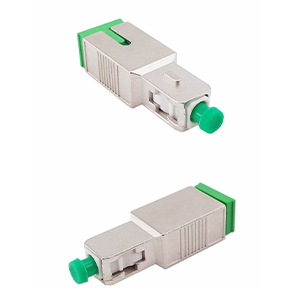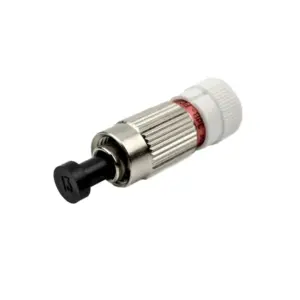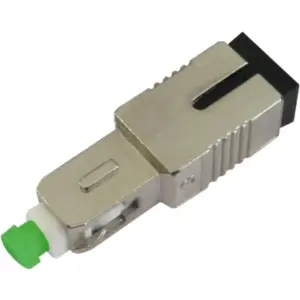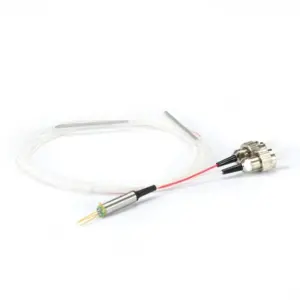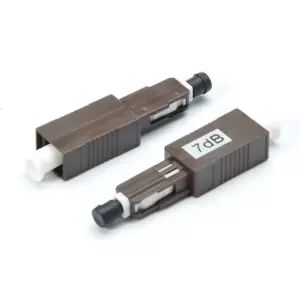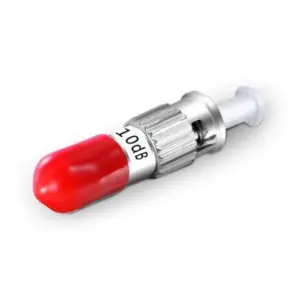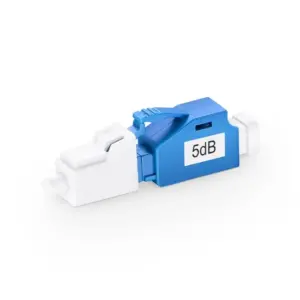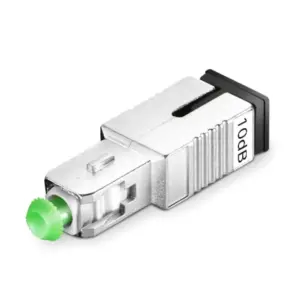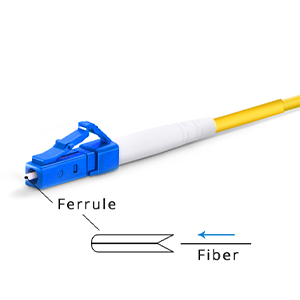Hello everyone! Today I am pleased to introduce to you an important device that plays a key role in fiber optic communication systems – fiber optic attenuators. As a key component for controlling and regulating optical power, fiber attenuators play an indispensable role in ensuring stable operation of the system and protecting key optoelectronic equipment. In this article, I will give you an in-depth analysis of the working principle and type characteristics of fiber optic attenuators, as well as its wide range of application scenarios in fiber optic networks. I believe this will help you choose the most appropriate attenuator and build high-performance fiber optic Communication Systems.
Overview of fiber attenuator principle
An optical fiber attenuator is an optical component used to control the intensity of optical signals. It adjusts optical power by weakening the intensity of optical signals. The following is the basic principle of fiber optic attenuator:
Working mechanism and principle:
Fiber optic attenuators generally operate on two main operating principles: absorption attenuation and scattering attenuation.
Absorption attenuation:Absorptive attenuators use materials with specific absorption properties, such as ceramics, tunable filters or special coatings. When an optical signal passes through these materials, part of the light energy is absorbed by the material, converting the light energy into heat energy, thus reducing the intensity of the optical signal. By adjusting the absorption properties of the material, different degrees of light attenuation can be achieved.
Scattering attenuation:Scattering attenuators use the scattering effect of materials to attenuate optical signals. When an optical signal passes through a scattering attenuator, small inhomogeneities or structures within the material cause the light to scatter, causing a portion of the light energy to leave the fiber in a scattered manner, thereby reducing the intensity of the optical signal.
Optical parameters involved in the light attenuation process:
In the fiber attenuation process, the following important optical parameters are involved:
Insertion Loss:Insertion loss refers to the optical power lost due to attenuation when the optical signal passes through the attenuator. The insertion loss of the attenuator should be as low as possible to ensure minimal optical signal loss.
Attenuation Value:The attenuation value refers to the actual attenuation amount of the fiber attenuator, usually expressed in decibels (dB). The larger the attenuation value, the stronger the attenuation effect of the attenuator on the optical signal.
Wavelength Dependence:The attenuation characteristics of an attenuator may vary with the wavelength of the optical signal. In some cases, the attenuation value of an attenuator may be wavelength dependent, which requires wavelength dependence to be considered when selecting an attenuator.
The key role of fiber optic attenuators in controlling optical power:
Fiber optic attenuators play a key role in optical fiber communications and optical networks and have the following important applications and functions:
Optical power control:Fiber optic attenuators can be used to control the intensity of an optical signal to match the operating range of a receiver or other optical component. By adjusting the attenuation value of the attenuator, you can ensure that the optical signal is transmitted at an appropriate power level in the network, preventing the optical signal from being too strong, causing receiver saturation, or being too weak, causing signal distortion or an increase in the bit error rate.
Power balancing:In fiber optic communication systems, there may be power differences in different optical path lengths or connections. Fiber optic attenuators can be used to balance optical power so that the optical signal power in each channel or connection is consistent. This is crucial to ensure system stability and performance.
Flexibility and adjustment:Fiber optic attenuators provide flexibility and adjustment capabilities to precisely control and adjust optical power according to needs. It can be used to adjust signal strength, balance power differences between different channels, and adapt to different network configurations and needs.
To sum up, fiber attenuators reduce optical power by absorbing or scattering optical signals, thereby achieving control and regulation of optical signals. It plays a key role in optical fiber communications and optical networks, used to control optical power, power equalization, and provide flexibility and adjustment capabilities.
What are the fiber attenuator types
Common optical fiber attenuators are mainly divided into two types: fixed attenuators and adjustable attenuators. They are introduced below and their respective characteristics, advantages and disadvantages, and application scenarios are explained.
- Fixed attenuator:
Fixed attenuators have a predetermined, fixed attenuation value that cannot be adjusted during use. It usually uses specific attenuation materials or devices to achieve a fixed attenuation amount.
Features:
- The attenuation value of the fixed attenuator is fixed and cannot be adjusted.
- Typically has lower insertion loss.
- Simple structure and relatively low price.
- Suitable for application scenarios that require fixed attenuation values.
Advantages:
- High stability, the attenuation value will not change due to changes in the external environment.
- The cost is low and suitable for a large number of scenarios requiring the same attenuation value.
- No adjustment required, easy to use.
Disadvantages:
- The attenuation value cannot be adjusted in real time and is not suitable for scenarios that require frequent adjustment of optical power.
- An appropriate fixed attenuation value needs to be selected in advance, which is not suitable for applications requiring high flexibility.
Application scenarios:
- In optical fiber communication systems, it is used to balance optical power to make the optical signal power in different channels or connections consistent.
In optical sensing systems, it is used to control the intensity of light signals to adapt to the sensitivity requirements of different sensors.
Adjustable attenuator:The adjustable attenuator has the characteristic of adjustable attenuation value, which can adjust the intensity of the optical signal in real time according to the needs. It usually uses some mechanical, electronic or optical methods to achieve attenuation adjustment.
Features:
- The attenuation value can be adjusted in real time, giving greater flexibility.
- Can be adjusted smoothly between different attenuation values.
- Adjustable attenuators usually have high insertion loss.
- The adjustable range and adjustment accuracy vary with different devices.
Advantages:
- The optical power can be flexibly adjusted according to actual needs, and is suitable for scenarios that require frequent adjustment of optical signal intensity.
- Can adapt to different fiber connections or system configuration changes.
Disadvantages:
- Usually more expensive.
- Some adjustable attenuators may have certain insertion loss and wavelength dependence during the adjustment process.
Application scenarios:
- In fiber optic communication systems, used to precisely control optical power to adapt to different optical path lengths, connections and equipment requirements.
- In the field of optical test and measurement, used to flexibly adjust optical power to meet test needs.
The differences between different attenuators in terms of flexibility, accuracy, etc.:
- Flexibility: Adjustable attenuators have higher flexibility and can adjust the attenuation value in real time to adapt to different needs. The attenuation value of a fixed attenuator is fixed and cannot be adjusted.
- Accuracy: Adjustable attenuators usually have high adjustment accuracy and can achieve more precise optical power control. The attenuation value of the fixed attenuator is predetermined, so the accuracy is relatively low.
Fixed attenuators and adjustable attenuators are two common types of fiber optic attenuators. The fixed attenuator has a fixed attenuation value and is suitable for scenarios where the attenuation amount needs to be determined. It has the advantages of high stability and low cost. The adjustable attenuator can adjust the attenuation value in real time according to the needs. It has strong flexibility and is suitable for applications that require frequent adjustment of optical power. The advantage of adjustable attenuators is that they are highly flexible and can adapt to different fiber connections and system configuration changes, but they are more expensive and may have certain problems with insertion loss and wavelength dependence.
In terms of flexibility, an adjustable attenuator is significantly better than a fixed attenuator because it can smoothly adjust between different attenuation values as needed to meet real-time requirements. The attenuation value of the fixed attenuator cannot be adjusted, and only the preset fixed value can be used.
In terms of accuracy, adjustable attenuators usually have higher adjustment accuracy and can achieve more precise optical power control. However, the accuracy of a fixed attenuator is low because its attenuation value is fixed and cannot be fine-tuned.
Depending on the specific application needs, the choice between a fixed or adjustable attenuator depends on the requirements for flexibility and accuracy. If you need to flexibly adjust optical power and meet changing needs in real time, an adjustable attenuator is a more suitable choice. If there are certain requirements for attenuation and frequent adjustments are not required, fixed attenuators are more economical and affordable.
In general, fixed attenuators are suitable for application scenarios where the attenuation value needs to be determined, while adjustable attenuators are suitable for scenarios where optical power needs to be flexibly adjusted, but the price is relatively high.
Where is fiber attenuator used?
Fiber optic attenuators have a variety of applications in optical fiber networks and are critical to improving the performance of optical communication systems. The following are typical applications of fiber optic attenuators in optical communication systems:
Optical power adjustment:Fiber optic attenuators are often used to adjust optical power so that the optical signal power in different channels or connections is consistent. In optical communication systems, optical signals may pass through different transmission media, connectors, optical splitters, etc., and these components will introduce different losses and attenuation. By using fiber optic attenuators, optical power can be accurately adjusted to balance the optical signal strength in each channel or connection to ensure the normal operation of the system.
Protect sensitive optoelectronic equipment:In optical communication systems, some sensitive optoelectronic equipment (such as receivers, optical amplifiers, etc.) are very sensitive to the intensity of the input optical signal. Optical power that is too high or too low may cause device performance degradation or damage. By using fiber optic attenuators, optical power can be accurately adjusted to protect sensitive optoelectronic equipment and ensure its normal operation.
System performance optimization:In optical communication systems, optical power requirements may vary between different fiber connections, transmission distances, and devices. Fiber optic attenuators can be used to optimize system performance and ensure that optical signals remain within the appropriate power range during transmission in various parts. By adjusting the optical power, the transmission efficiency, signal quality and bit error rate performance of the system can be maximized.
Here are some reasons why fiber optic attenuators play a key role in improving system performance:
Precise power control: Fiber optic attenuators can provide precise optical power adjustment to keep optical signals within the appropriate power range when transmitted in the system. This helps avoid performance problems caused by too high or too low optical power and ensures system stability and reliability.
Balanced optical signals: There may be multiple channels or connections in an optical communication system, and the optical power of each channel or connection may be inconsistent. By using fiber optic attenuators, you can balance the strength of optical signals in individual channels or connections, ensuring they operate at the same power level, thereby improving the overall performance of your fiber optic network.
Protect sensitive equipment: Some optoelectronic equipment in optical communication systems are very sensitive to input optical power. Fiber optic attenuators can be used to protect these sensitive devices and ensure that they operate within the appropriate optical power range. By controlling optical power, the risk of equipment damage can be reduced and the reliability and life of the system can be improved.
In summary, fiber optic attenuators have important applications in optical communication systems. They can be used to regulate optical power, protect sensitive optoelectronic equipment, and optimize system performance. By precisely controlling optical power, fiber optic attenuators can improve the performance, stability and reliability of fiber optic networks and ensure the transmission quality and efficiency of optical signals in the system.
How to choose and use fiber attenuator
The following key factors need to be considered when selecting and using fiber optic attenuators:
Attenuation range: Determine the required attenuation range according to actual needs. Different application scenarios may require different amounts of attenuation, so it is necessary to select a fiber attenuator with an appropriate attenuation range.
Attenuation accuracy: Attenuation accuracy refers to the deviation between the actual attenuation provided by the attenuator and the nominal attenuation. For some applications, such as high-speed optical communication systems, attenuators are required to provide high-precision attenuation to ensure system performance.
Wavelength Compatibility: Fiber optic attenuators should be compatible with the wavelength used by the system. Select the appropriate fiber attenuator based on the wavelength range used by the system to ensure its proper operation.
Return loss: Return loss refers to the signal reflection introduced by the fiber attenuator when attenuating the optical signal. For some applications, such as high-speed optical communication systems, attenuators are required to have low return loss to reduce the impact of signal reflections on system performance.
Insertion loss: Insertion loss refers to the attenuation of the optical signal by the fiber attenuator itself. Choose a fiber attenuator with lower insertion loss to ensure the quality of the optical signal in your system.
When installing and debugging fiber optic attenuators, you should pay attention to the following steps:
Determine the installation location: based on system requirementsand layout, choose the appropriate installation location. Typically, fiber optic attenuators are installed at specific locations in fiber optic links, such as between connectors or inside fiber optic splice boxes.
Clean the connector and fiber: Before installing the attenuator, make sure the connector and fiber end face are clean. Use appropriate cleaning tools and methods to clean connectors and optical fibers to reduce insertion loss and return loss at attenuator connections.
Connecting the attenuator: Insert the fiber optic attenuator correctly between the connectors, making sure the insertion is secure and properly aligned. Avoid bending the fiber excessively to avoid additional losses.
Testing and debugging: After installation is complete, test the system using an appropriate optical power meter or spectrometer to verify the performance and attenuation of the fiber attenuator. Adjust and calibrate as needed to ensure attenuator accuracy and stability.
Frequently asked questions and troubleshooting measures:
Insertion loss is too high: It may be caused by poor attenuator connection, dirty or damaged fiber end face, etc. Solutions include re-cleaning the connector and fiber end-face, checking the attenuator connections, and reinserting them.
Excessive return loss: This may be due to poor quality attenuators, bad connectors, or a mismatch between the fiber attenuator and other components. Solutions include replacing the attenuator, checking and replacing defective connectors, and ensuring compatibility of the fiber optic attenuator with other components.
Large deviation in attenuation: It may be caused by the mismatch between the nominal attenuation of the attenuator and the actual attenuation or the quality of the attenuator. Solutions include selecting reliable quality attenuators and using accurate test equipment for verification and calibration.
Wavelength mismatch: A mismatch between the wavelength range of the attenuator and the wavelength used by the system may result in inaccurate attenuation effects. Be sure to select an attenuator that matches the wavelength of your system to avoid problems caused by wavelength mismatch.
Abnormal system performance: If the system performance is abnormal after installing an attenuator, it may be due to inaccurate attenuation introduced by the attenuator or other problems. In this case, the connection, attenuation and quality of the attenuator should be carefully checked and compared with the system requirements for troubleshooting and repair.
In short, multiple factors need to be considered when selecting and using fiber optic attenuators, such as attenuation range, attenuation accuracy, wavelength compatibility, etc. Proper installation and commissioning of the attenuator is key to ensuring proper operation, including cleaning the connector and fiber, connecting the attenuator correctly, and performing testing and adjustments. Common problems such as insertion loss, excessive return loss, attenuation deviation, etc. can be solved by checking the connections, replacing the attenuator or calibrating.
Summary
Optical fiber attenuator is undoubtedly an important part of the optical fiber communication system. It can accurately control optical power, ensure stable operation of the system, and protect key optoelectronic equipment from excessive optical power. We provide various types of fiber optic attenuators, including fixed attenuators and adjustable attenuators, to meet your needs in different application scenarios.
Whether it is optical power adjustment, system protection or other applications, fiber optic attenuator play a vital role. If you have any questions or needs about fiber optic attenuators, please feel free to contact us. Let us work together to build efficient and reliable optical fiber communication network infrastructure and promote the development of digital transformation!
fiber attenuator FAQ
The primary causes of fiber attenuation include absorption, scattering, and bending losses. Factors like material impurities, fiber imperfections, and tight bends in the fiber can contribute to increased attenuation.
Different fiber types have varying levels of attenuation. Generally, single-mode fibers have lower attenuation compared to multimode fibers, making them more suitable for longer-distance transmission.
Single-mode fibers typically have an attenuation range of 0.2 to 0.4 dB/km at the 1310 nm wavelength, and 0.15 to 0.25 dB/km at the 1550 nm wavelength. Multimode fibers have higher attenuation, typically ranging from 1 to 3 dB/km.
Fiber attenuation is wavelength-dependent. Certain wavelengths experience lower attenuation, known as “low-loss windows,” which are commonly used in fiber optic communications. The 1310 nm and 1550 nm wavelengths are the primary low-loss windows.
Yes, fiber attenuation can be measured using specialized equipment, such as an optical power meter and a light source. This process is known as an optical loss test set (OLTS) measurement, which provides the attenuation value in dB.
Factors like cable length, the number of splices and connectors, environmental conditions, and the quality of the installation can all impact the actual attenuation experienced in a fiber optic network.
Techniques to minimize fiber attenuation include using high-quality fibers, properly splicing and terminating connections, avoiding tight bends, and selecting the optimum wavelength for the application.
Knowing the fiber attenuation characteristics is crucial for designing fiber optic networks, as it helps determine the maximum transmission distances, the need for amplifiers or repeaters, and the power budget required for the system.
Excessive fiber attenuation can lead to signal degradation, reduced transmission distances, and potential communication failures. Understanding and managing fiber attenuation is essential for ensuring the reliable operation of fiber optic networks.

